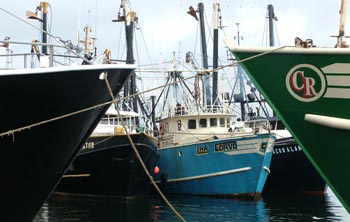Lockdown In Framework 42
by Laurie Schreiber
|
Groundfishermen are facing yet another cut in the number of days they may fish. In the Gulf of Maine and Southern New England, each of their days at sea (DAS) will be counted as two days, as of Nov. 22.
The measure from the New England Fisheries Management Council (NEFMC) is part of Framework 42 for Amendment 13 to the groundfish management plan for federal waters in the Northeast, and covers 19 stocks, including cod, haddock, and many flounders.
Average available fishing days dropped from about 116 in 1996 to just 52 Category A DAS; fishermen are losing an additional 8 percent of their days with FW42’s implementation. A13 contains default measures for 2009 that, if implemented, will further reduce DAS and potentially trigger a new trip limits and area closures. Another FW42 measure requires vessels operating with a groundfish DAS permit to be equipped with a vessel monitoring system. Vessel operators are eligible for reimbursement through a program instituted by the National Marine Fisheries Service (NMFS) earlier this month. A provision that would have allowed trip limits to be raised for six species was disapproved.
The Midcoast Fishermen’s Association (MFA) called the scenario “a disaster” for the many groundfishermen trying to pay off debts under “almost impossible circumstances,” said MFA chairman Glen Libby. “The fish will come back, this will be a viable fishery in the not too distant future, and Maine is positioned to have a
|

The Midcoast Fishermen’s Association (MFA) called the scenario “a disaster” for the many groundfishermen trying to pay off debts under “almost impossible circumstances. The fish will come back, this will be a viable fishery in the not too distant future, and Maine is positioned to have a great economic boom from this recovered fishery.” —Glen Libby, MFA chairman Photo: Fishermen's Voice |
|
|
|
|
The Yankee Gale of '51
by Susan Whittaker
|
In 1994, in a small graveyard behind Christ Church on Kildare Cape, Prince Edward Island, three bodies wrapped in sailcloth were unearthed during the burial of a neighborhood woman. To determine when these sailors died, local historians began researching nineteenth century storms that were violent enough to cast bodies upon their shore. The only storm fitting the description was the Yankee Gale of October 1851.
In those days, a treaty with Great Britain allowed American vessels to fish the Maritimes. Stocks were plentiful then and more than twenty thousand vessels employing no less than 250,000 men fished from May to December; first making cod runs off the coast of Newfoundland, then fishing mackerel from Prince Edward Island’s coast which includes the Magdalen Islands, Gulf of Saint Lawrence to the north and the Northumberland Straight to the south. PEI’s newspaper, The Islander, reported that “the vessels congregated at one time will often amount to two thousand sail, although as a general thing not more than two to four hundred vessels sail in company. At night when the fleet is safely anchored, the lanterns lighted on each vessel and hanging from the shrouds, one may fancy himself looking upon some huge city lying in repose, with its lamps all trimmed and burning.”
continue
|
| George Thresher, The Yankee Gale, 1851. Oil on canvas. Canadian Confederation Art Gallery. Painter George Thresher was Registrar of Deeds in Charlottetown, Prince Edward Island from 1829 to 1857. He was an eyewitness to the Gale of ’51. Photo: Courtesy of Confederation Centre Art Gallery, Charlottetown, Prince Edward Island |
|
|
|
|
|
  
|
|

